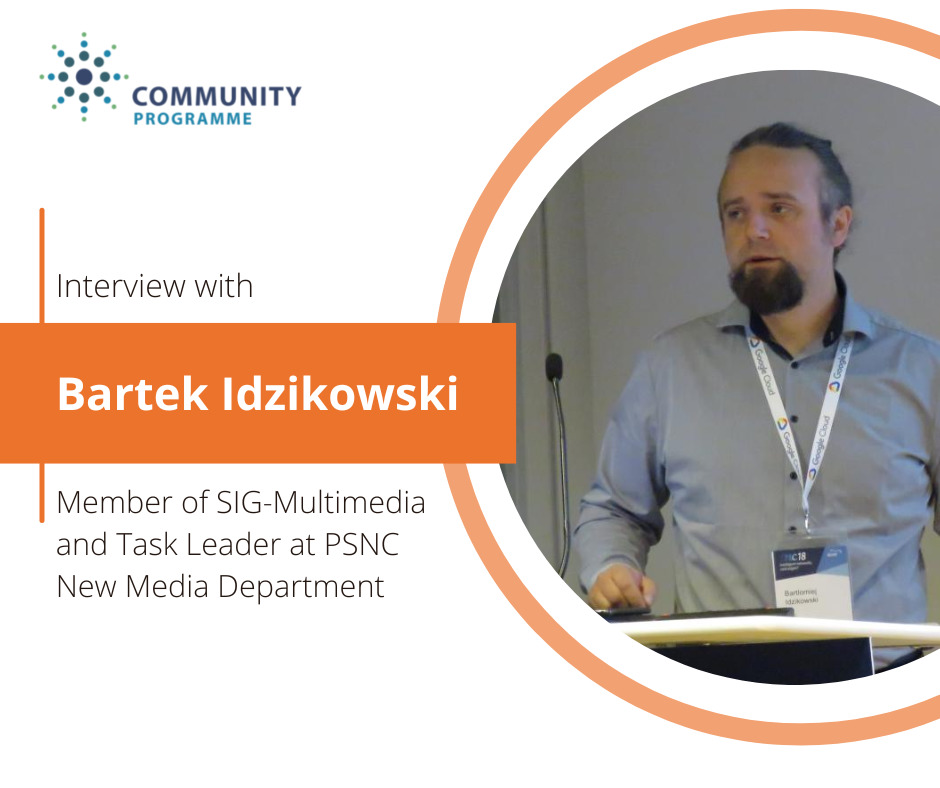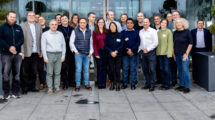This interview is part of a series highlighting the objectives, roles and mission of GÉANT Community Programme’s special interest groups and task forces.
We interview Bartlomiej (Bartek) Idzikowski who is the Task Leader of the eduMEET / eduTURN task in GÉANT, technical coordinator of TNC, coordinator of the scientific TV team (Pionier TV) and steering committee member of the Special Interest Group Multimedia. After graduating from Poznan University of Technology in 2003 (Computing Science – Computer Networks and Distributed Systems), he became PSNC employee in the organisation’s Network Department. His research interests focus on video- and web-conferencing, high resolution video systems (4K, 8K), web-based applications, streaming technologies, network management and traffic monitoring. Bartłomiej’s professional background includes long-term cooperation within different European and national projects, such as GN2, GN3, GN3plus, GN4-1, GN4-2, GN4-3, 6NET, Phosphorus, Porta Optica Study, VISIONAIR, ImmersiaTV and Immersify. He was a member of the TNC programme committee in 2011, 2012 and 2013 and a member of the TERENA NRENum.net task force.
Your contribution to the community, Bartek, is outstanding. Not only you are part of SIG-Multimedia’s Steering Committee, but you play a key role in building the behind the scenes of every TNC with your team at PSNC, and have also been awarded the Medal of Honor by the Vietsch Foundation in 2020. What does it mean to you to play an active part in the community?
It is both work for the community and the community itself that give sense to my job and my position. Similarly to a network, which is useless without services, my work without community would be pointless and senseless; and this is both valid and important to me for all the areas of my involvement and expertise.
As the task leader of eduMEET, I support, together with my team, NRENs and organisations that would not be able to buy commercial web-conferencing systems otherwise. We are focusing also on security and privacy of collaboration systems, with the main aim of building awareness about these important aspects. With the community and for the community as the foundations of this involvement. My active commitment in GÉANT’s Event Team is about technical coordination of TNCs, as well as other events organised by GÉANT, prepared with and for the community. Again – “community” is the keyword here! These events without speakers, participants, committees would not exist at all. So I can only repeat that the community gives the very sense to this part of my work and my involvement. Being part of SIG-Multimedia is another area of engagement with main goal to collaborate with the community. The group consists of community members and has been established to serve it. Again – it’s crucial for the very existence of the SIG!
I see the Vietsch Foundation Medal of Honour as very straight and important feedback from the community, and I appreciate it very much! It’s a proof that our approach is the proper one. It made us even more committed to continuing our work, as well as extending and polishing existing solutions and workflows. I want to strongly underline here that I treat the Medal of Honour as an acknowledgement of the dedication and work of all members of the team I’m working with. As we said together with Erik Kikkenborg from NORDUnet (co-awarded) – without our teams, just by ourselves, we would only be able perhaps to perform a gymnastic tumble on stage, and this would probably not even be a good one…
What is your role within SIG-Multimedia and how does it influence your daily work in the New Media Department of PSNC?
I’m one of steering committee members of SIG-Multimedia. While performing my daily duties, I always keep in mind how they can support the community, also via the SIG. Through sharing experiences, not just my own, but of the whole PSNC’s New Media Department, I hope to help expand the expertise of other NRENs and organisations. This works of course also the other way round, so we are able to learn from the work of our partners at SIG-Multimedia. This is all about the community and collaboration again.
Multimedia tools and applications have played a crucial role for the education institutions and research centres in our community during the COVID-19 pandemic. Now that we are settling into a “new normal” with mostly hybrid meetings, how to you expect the focus of SIG-Multimedia to shift? Or has it already?
Indeed, during the pandemic, people were forced to switch to virtual meetings. Even big and important conferences, as TNC21, were held fully online. Artistic events, like concerts or theatre performances, were transmitted online during lockdowns. For example, PSNC performed the first online transmission from a theatre just several hours after the lockdown had been announced in Poland. Quite a challenge, but it was definitively worth doing. The pandemic made online solutions popular! People have become more and more familiar with them and they are no longer afraid of online meetings anymore. Thanks to this more flexible approach, hybrid conferences became possible and are now much more popular than before. Also live streams from theatres are still going on, often in parallel to traditional, live audience model.
SIG-Multimedia needs to adapt to this new type of reality and, of course, this process has already started. Searching, sharing and advising appropriate solutions to the whole community is our duty at SIG-Multimedia.
Nowadays, high-end users are more demanding and require fully reliable and cutting-edge applications. How is the community addressing this increase?
I can see two parallel ways of adapting to this demanding situation within the scope of media related solutions. One of them is extending the cloud portfolio with new applications, also from commercial providers, to address the needs of high-end users. This approach is mainly aimed at those organisations in the community that are able to contribute to the costs of this type of delivery of functionalities and applications.
And then there are applications and services developed within our community. These are aimed at organisations that can handle daily maintenance of on-premise installations on their own infrastructure – for their own users. eduMEET and eduTURN services are examples from my area of expertise. In this case, it’s our duty to address the needs of the community, which are reported by its representatives, such as users and their organisations.
As I do point out very often, on behalf of eduMEET team – we are part of the community and we listen to our community. If some functional features are important – we are able to adjust the roadmap in order to adapt or extend functional areas where needed. This is also the way we are addressing the increase of these quality and reliability demands.
More recently, PSNC was awarded funds within the multimedia field of the GÉANT Innovation Programme to develop drawOnMeet, an extension of eduMEET which will allow participants in a video conference to draw on any video stream, not only their own screen share. Can you tell us how this solution will benefit the community?
Actually drawing on video was not possible before, not even on one’s own screen share (except with a pen on one’s own monitor). But now, every video can be used for shared drawings by all participants of the web-conference.
The most common use case scenario is about medical consultations between doctors. In fact, the medical community, including universities and hospitals, was the first to let us know about such a need. During discussions or lectures, participants can easily point or underline the area of the picture they are discussing at a particular moment. As they say – a picture is worth more than a thousand words, especially in the context of complex, scientifically topics. Making the discussion clearer helps to ensure that everything is understood in the same way by all participants in the virtual meeting. And “virtual” is a keyword here – during a face to face meeting it would be much easier! So drawOnMeet is kind of the next step towards easier and more convenient virtual meetings, bringing us a little bit closer to the real word.
Stay updated on SIG-Multimedia’s activities, achievements and future meetings on the SIG’s webpage.
More on the GÉANT Community Programme, its mission and tasks can be found here.







